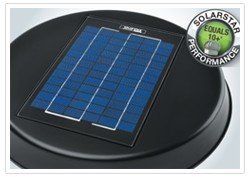In most of Australia, having air conditioning isn’t just a convenience – it’s a necessity if you want to be able to be comfortable in your own home all year long. In fact, Australians’ interest in air conditioning extends back a century and a half, when journalist and politician James Harrison developed an ice-making machine that relied on a condenser system to cool air as it circulated through his machine. It wasn’t until a half century later, though, that American Willis Carrier developed the first commercially successful electrical air conditioning system. It wasn’t long before air conditioning became widely available in homes as well as businesses, and the rest, as they say, is history.

Solar Star
Short Life Spans
Despite all the advances during the past 150 years since Harrison’s experiments with ice-making, air conditioning units still have a relatively short lifespan – typically a dozen or so years – and considering the expense in purchasing and installing an air conditioning system, it just makes sense to take every step possible to maintain a system for as long as possible.
Many air conditioning systems wind up breaking down far sooner, thanks to excessive wear and tear that can occur when a system’s performance is taxed repeatedly. To ensure a system lasts – or even outlasts – its average lifespan means you need to do what you can to reduce the wear and tear that can cause early system failure. One of the ways to do that is to take additional action to keep the air in your home as cool and dry as possible.
Air conditioners use ductwork to draw warm air from outside your home, passing the air across a condenser unit that cools the air before reintroducing it to your home. When the air inside the ducts is hotter, that means the condenser has to work much harder to reduce the temperature of the air, and that extra work is the primary cause of excessive wear and tear and early system breakdown.
How a Solar Star Can Help
Having a roof ventilation system can help preserve the life of your system by “pre-cooling” the air before it enters the air conditioning system, removing the hot air that collects in your attic space so your air conditioning ductwork and your whole home stays cooler. In addition, a powerful ventilation system like a Solar Star helps reduce the moisture in your home’s air, making it even easier for the air conditioner to do its job.
Of course, traditional fan-assisted roof ventilation systems cost money to operate, and depending on the type of fan they use, and how frequently they need to run to keep your home cool, the cost savings associated with preserving your air conditioning unit can be offset considerably by the operational costs associated with running a roof fan for long periods. That’s when having a Solar Star roof ventilation system really makes great financial sense.
The Solar Star uses a high-efficiency fan unit powered by solar panels, so you get all the advantages of a powerful roof fan without the added operational costs. Moreover, because the Solar Star installation process is simple and straightforward, the return on your investment can be substantial – not only will your home be cooler and drier, but the load on your air conditioning unit can be significantly decreased as well.
If you have an air conditioning unit in your home, you owe it to yourself – and your budget – to explore the Solar Star roof ventilation system. Ready to learn more? To find a skylight dealer in Hobart, just click here, or contact us to find a dealer near you.

